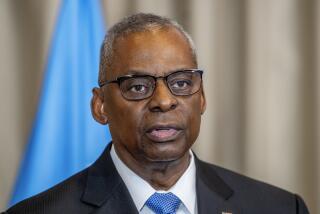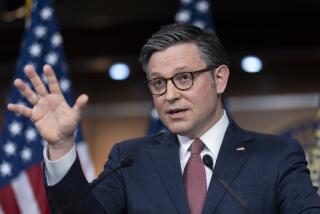Cuts to defense budget threatened by battle against Islamic State
Members of Congress and the White House anticipated a peace dividend by winding down America’s foreign wars, closing bases and shedding tens of thousands of troops.
But President Obama’s new, open-ended strategy to confront Islamic State fighters in Iraq and Syria is likely to eat into some of the nearly $500 billion in Pentagon spending cuts that were planned over the next decade.
The first five weeks of U.S. airstrikes in northern Iraq has cost $262.5 million, according to the Pentagon, and Obama personally lobbied key members of Congress in recent days to appropriate $500 million to help train and arm Syrian rebels at camps in Saudi Arabia.
While that’s still a pittance compared with the total $496-billion Pentagon budget, or the $1.2 trillion spent for the ground wars in Iraq and Afghanistan, the costs of intervention are certain to increase under the plan to step up airstrikes, intensify surveillance and conduct counter-terrorism operations against the Sunni extremist force and its leaders.
There are already calls in Congress to eliminate the $45 billion in sequestration spending cuts that are set to hit next fiscal year, which starts Oct. 1, and to increase the supplemental appropriations used to fund the actual war-fighting, as opposed to other parts of the Pentagon budget.
Rep. Peter T. King (R-N.Y.), who chairs a House subcommittee on counter-terrorism and intelligence, said lawmakers should reconsider cuts to the defense budget to ensure the latest military venture is funded for the long haul.
“This is not just bombing a mountainside or securing a dam,” he said. “This is a war that could go on for another 10, 15 years. And to do that we’re going to have to recalibrate our thinking toward defense, and realize that we have to be on a wartime footing when it comes to spending.”
House Minority Leader Nancy Pelosi (D-San Francisco) said budget discussions were already underway to address the new national security priorities.
“Every time we talk about any initiative for the use of force or the initiation of hostilities, it’s a question of resources,” she said. “There is a concern and it’s been brought up in our meetings. But we have a first responsibility to protect and defend. That is the oath we take.”
The military action has meant a policy reversal for Obama, who vowed in May 2013 to take America off its “permanent war footing” and to curtail the use of drones. As of Saturday, the U.S. had launched 160 airstrikes in northern Iraq in five weeks, compared with 147 drone strikes over the last three years in northwest Pakistan, where Al Qaeda is still based.
For lawmakers, voting to increase military spending may be easier than approving other spending hikes, given the public outcry since videos surfaced last month showing Islamic State fighters beheading two American journalists. A third video released Saturday appeared to show the beheading of a British aid worker. Opinion polls show broad public support for U.S. airstrikes against the insurgents.
“Further reductions in Pentagon spending are unlikely [because] public sentiment has turned,” said Loren Thompson, military policy analyst for the Lexington Institute in Arlington, Va., which advises defense contractors.
“The unexpected surge of overseas threats will probably put a brake on further cuts in defense spending, and generate pressure to amend the 2011 Budget Control Act,” he added.
The act, part of which included mandatory cuts known as sequestration, trimmed about $500 billion from Pentagon spending over the next decade by putting annual caps on the defense budget.
In a study released in April, the Pentagon outlined the impact of those mandatory cuts, including a drop to 420,000 active-duty soldiers from 470,000 in the Army; the retirement of a Navy aircraft carrier; and scrapping the KC-10 tankers that refuel fighter and bomber jets in midair.
Since taking office in February 2013, Defense Secretary Chuck Hagel has unfurled a range of reform initiatives, including reducing the size of headquarters staff, slashing the number of troops and retiring fleets of Cold War-era aircraft.
The Center for Strategic and Budgetary Assessments, a Washington-based think tank, concluded in a recent report that inflation-adjusted defense spending has declined 21% since 2010. This includes special supplementary appropriations for the wars in Iraq and Afghanistan, which are considered “overseas contingency operations.”
The Pentagon was under pressure to lower war-related spending in the latest budget round of requests for fiscal 2015. At the time, the Pentagon requested $58.6 billion, which is about $20 billion less than the 2014 request.
But the budgets were drawn before the Islamic State fighters began seizing major cities and towns in western and northern Iraq last spring. The overseas contingency operations request, which still must be voted on by Congress, will likely be increased while the $496-billion base budget request for 2015 will stay untouched, analysts say.
“The impact of the current crisis is that the Congress and the White House will mutually agree to actually increase the defense budget, through the war budget, without compromising the budget deal,” said Gordon Adams, a defense budget expert at American University and a former official with the Office of Management and Budget.
In addition to ratcheting up the effort in Iraq and Syria, the Pentagon plans to train and provide body armor, night-vision goggles and medical kits to Ukrainian military forces facing an insurgency by Russian-backed separatists. That is expected to cost $70 million.
Hawks in Congress argue that the Islamic State threat shows the folly of cutting military spending. Speaking at a conference Thursday, Rep. Howard “Buck” McKeon (R-Santa Clarita), who chairs the House Armed Services Committee, said funding cuts had “hollowed out” America’s armed forces.
Rep. Mac Thornberry (R-Texas), the committee’s vice chairman, questioned whether the nation was safe with rising threats around the world.
“After the defense cuts and intelligence disclosures of the last few years, we are not as well positioned to prevent terrorist attacks as we were three to four years ago,” he said. “To keep Americans safe and maintain global leadership, Congress and President Obama must work together to develop a long-term national security strategy and then stick with it.”
Lisa Mascaro and Michael A. Memoli in the Washington bureau contributed to this report.
More to Read
Start your day right
Sign up for Essential California for news, features and recommendations from the L.A. Times and beyond in your inbox six days a week.
You may occasionally receive promotional content from the Los Angeles Times.







